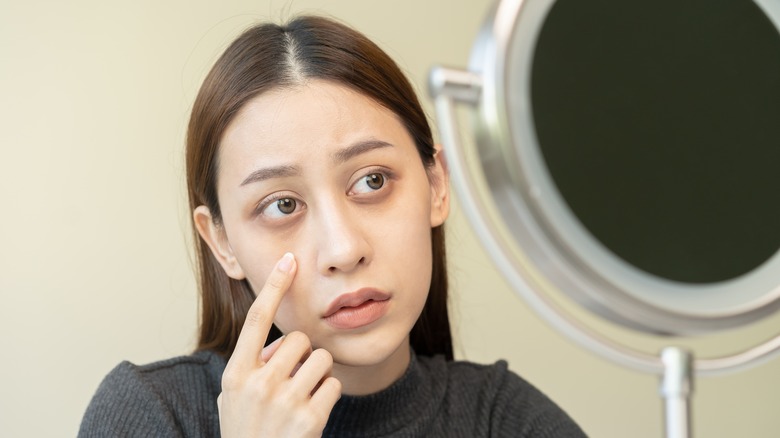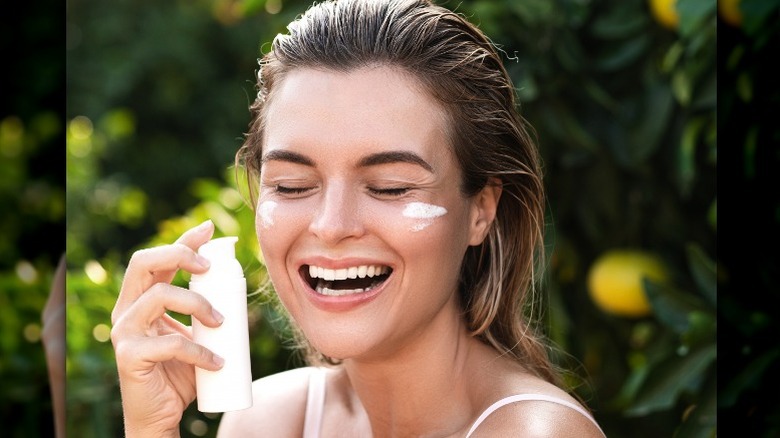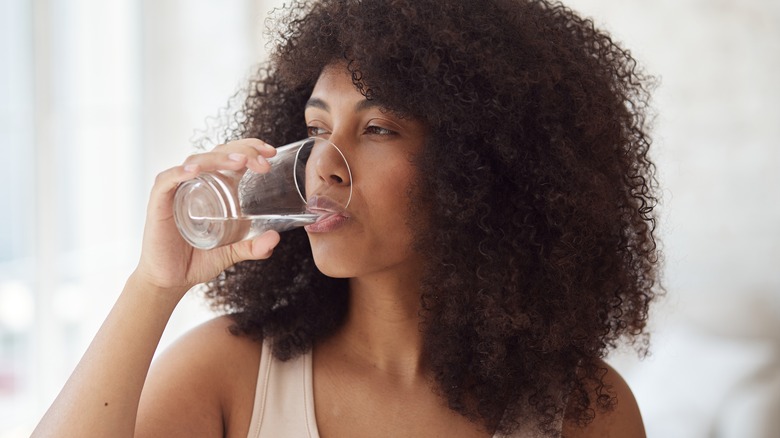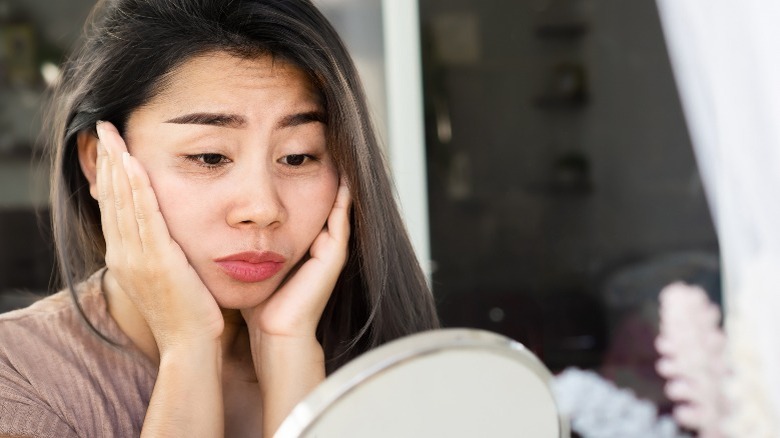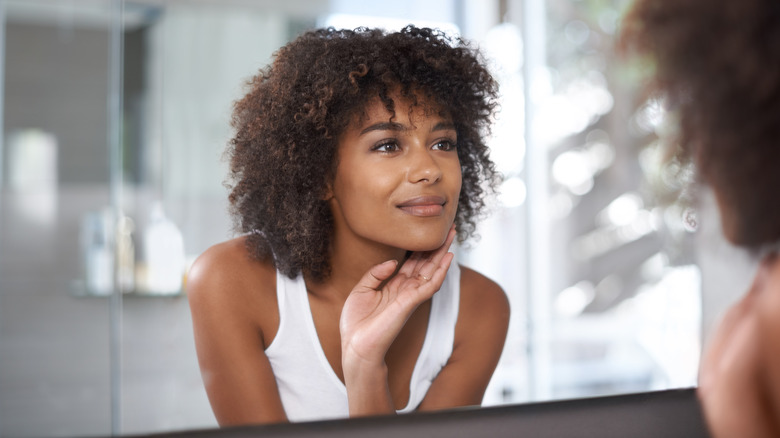Are Under-Eyes Supposed To Be Dark? Stopping The Fight Might Be Better For Your Face (& Self-Image)
Dark circles beneath your eyes, under-eye bags, darkness under your lower lids, or any version of phrasing along these lines refers to dark shading beneath the eye sockets and just above the top of the cheek bones, an aesthetic sensation which has for generations been rejected as unfavorable. Darker shades beneath the eyes can be symptomatic of a temporary condition such as insufficient sleep, or dark tones in the under-eye area can be part of your genetic makeup and, thus, may be perfectly normal for your body.
These darker tints beneath your eyes could be no indication of something awry, though dark hues colloquially called under-eye bags can be a sign or symptom of an underlying condition which should be promptly addressed. Culturally, there has been a shift in recent years which has even culminated in a 2021 TikTok trend which saw users on the platform embrace the perception of dark circles beneath the eyes as imperfections needing to be dispelled and authentic beauty celebrated. Often referred to as discoloration, bags beneath the eyes, or under-eye shading, this cosmetic phenomenon lacks much-needed education on its causes and significance.
An intentionally lighthearted life can decrease dark under-eye discoloration
Your lifestyle habits influence the presentation of dark under-eye areas, though it's important to recall that not every example of under-eye discoloration can be controlled since factors, including genetics, also contribute. For basic lifestyle practices you can actively manage to say goodbye to under-eye discoloration, kick to the curb alcohol consumption, cigarette smoking, and the consumption of other harmful substances through the respiratory system and into the lungs. Pulling all-nighters or trying to get by on minimal sleep is also a habit to drop. Stress and eyestrain, particularly from staring at electronic screens with artificial blue light for hours at a time, are additional contributors to dark circles which can be altered for better control over the well-being of your under-eye area and body as a whole. Applying daily sunscreen for protection from sun-induced hyperpigmentation and managing health conditions in which under-eye discoloration is a symptom, such as anemia, can also make them less visible.
There is some debate over how much our nightly sleep quality and consistency actually contribute to the development or reduction of dark under-eye circles, with other factors such as allergies and hereditary markers being considered the more likely culprits of under-eye discoloration. However, practicing healthy sleep hygiene and prioritizing sufficient sleep can aid your body's immune system to better fight allergies and maintain your overall wellness.
Drink water to quench dark discoloration beneath the eyes
One cause for dark discoloration under the eyes is dehydration, which everyone is prone to experience if your daily water intake isn't sufficient and your fluid retention is ultimately made unsustainable, especially if you replace water and healthy beverage options with sodas and alcoholic options. However, genetics and other uncontrollable factors come into play here as well since dehydration can lead to the appearance of skin beneath the eyes that's seemingly sinking into the space between your eye sockets and upper cheekbones, with the depth between the eyes and skin playing a key role in whether this aesthetic forms when a person gets dehydrated. For some people who have little internal space between their eyes and skin, slight dehydration can lead to a sunken look with dark discoloration under the eyes, while others with a different anatomical makeup may have an entirely opposite experience.
Once again, the development of dark under-eye circles or eye bags is heavily dependent on each person's unique body, but the reminder to drink enough water each and every day is universal. According to the Mayo Clinic, adult women should drink approximately 12 cups of water each day for an estimated 2.7 liters every 24 hours, while adult men should aim for 15 cups of good ol' H2O on a daily basis for a cumulative amount of 3.7 liters. When in doubt, drink an extra glass of water!
Predisposition is passed down from past generations
The reason darker shading appears beneath the eyes often has less to do with external, controllable factors such as hydration and sleep quality and more to do with the actual composition of your body, relying on genetic predispositions and hereditary factors which may go all the way back through generations of your ancestors. People whose bodies possess more melanin, the pigment within skin cells, are more likely to experience dark under-eye shading than people of lighter complexions or ethnicities. As such, those with ancestry which can be traced to the Eastern Mediterranean region are also more prone to experience naturally-occurring dark under-eye circles. At times, under-eye discoloration and puffiness can result from allergic reactions or dermatitis, so pay attention to developments, and consult with a healthcare professional if you have concerns.
Yes, your dark discoloration beneath your eyes may be an unintended gift from your genetics, but take a moment to recognize all the positives you have inherited from your ancestors, and encourage yourself to express gratitude towards your body. As you take stock of the parts of your body you dislike yet aren't able to change due to genetics, try not to dwell on the negative, and be grateful for your genetics and your heritage.
Accepting dark circles contributes to aging gracefully
A major factor provoking dark under-eye circles to become more prevalent over time is the mere act of aging. As you age, your skin simultaneously thins and loosens, increasing the appearance of darkness under your eyes, especially as the blood vessels beneath the skin become more visible. During the aging process, the body undergoes vast changes, and, frankly, the increased likelihood of under-eye discoloration is probably the least of the age-related changes worth worrying about.
Ways to age gracefully — which refers to the joyful mindset many nonagenarians carry with them through their many years of life — include laughing, learning, remaining curious, expressing gratitude, cultivating mindfulness and appreciation for oneself and the present, and connecting with others. Forgiveness is another factor of aging with grace; this includes forgiving harsh self-criticism of your appearance.
If a secret to aging gracefully – and glamorously — exists, it's the acceptance of a person's abilities, appearance, and age-related experiences, followed by adapting one's lifestyle and habits accordingly.
Enhancing self-esteem can open your eyes and dissuade dark perceptions
Prioritizing sleep, hydration, sunscreen, and foods rich in vitamins C, K, iron, and collagen are lifestyle habits which keep dark circles away while keeping you at your best. Yet, contemporary beauty standards place weight on going to great measures to correct imperfections, such as dark under-eye circles, which may realistically be normal bodily functions or aesthetics. Doing what you can to maintain healthy habits for your holistic wellness and learning how to age gracefully, cultivating mindfulness and meditation practices early on, are factors which are reasonably within your control when addressing dark under-eye discoloration. The best approach you can take for your mental and physical health is prioritizing self-love, as confidence and self-esteem can boost mood and longevity.
Social media users have used the globally collaborative digital landscape to celebrate natural functions and physical appearances of the human body, emphasizing embracing experiences such as under-eye shading instead of shaming, stigmatizing, and going to excessive lengths to hide such elements of the body. If you can, transition your focus towards creating experiences filled with laughter, joy, and genuine interpersonal connections, plus lots of self-love!
